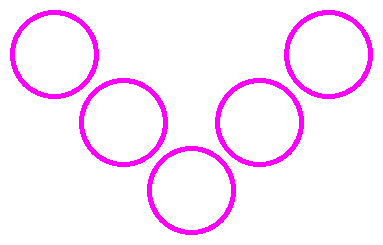Or search by topic
Number and algebra
Geometry and measure
Probability and statistics
Working mathematically
Advanced mathematics
For younger learners
Magic Vs



The problem is explained below, but you may wish to scroll to the foot of the page to watch a video of the NRICH team presenting this challenge.
Place each of the numbers 1 to 5 in the V shape below so that the two arms of the V have the same total.

How many different possibilities are there?
What do you notice about all the solutions you find?
Can you explain what you see?
Can you convince someone that you have all the solutions?
What happens if we use the numbers from 2 to 6? From 12 to 16? From 37 to 41? From 103 to 107?
What can you discover about a V that has arms of length four using the numbers 1 to 7?
Here is a video of the NRICH team presenting the challenge. You could just watch the start to check that you understand the problem, or you may like to pause the video and work on the task at various points.
Click here for a poster of this problem.
If you have enjoyed this problem, you might like to explore Magic Letters.
Related Collections
You may also like
Consecutive Numbers
An investigation involving adding and subtracting sets of consecutive numbers. Lots to find out, lots to explore.
Roll These Dice
Roll two red dice and a green dice. Add the two numbers on the red dice and take away the number on the green. What are all the different possible answers?

